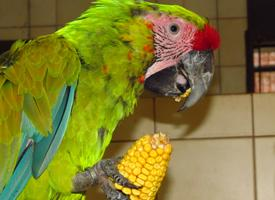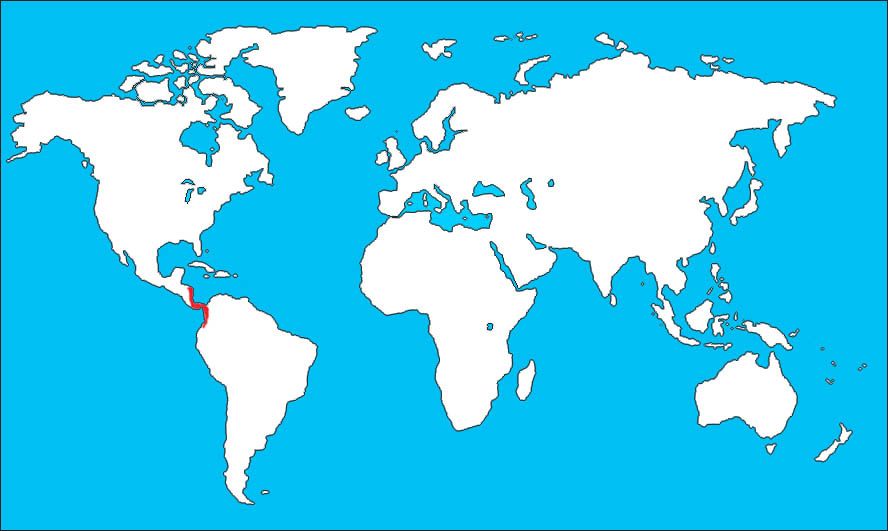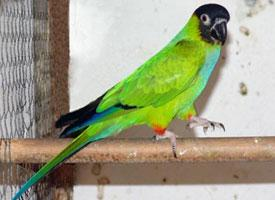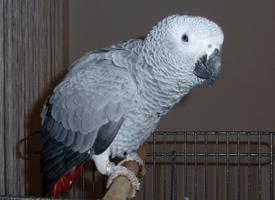
Greutăți și măsuri
| Lungime | de la 85 la 90 cm |
|---|---|
| Greutate | 1,3 kg |
Starea de conservare
| Neînfricat |
Descrierea animalului
The Great Green Macaw (Ara ambiguus), also known as Buffon's Macaw or the Great Military Macaw, is a magnificent and vibrant bird species that belongs to the Psittacidae family, which encompasses parrots and related species. This large parrot is native to the humid evergreen forests of Central and South America, with its range extending from Honduras through Nicaragua, Costa Rica, and Panama, into Colombia, Ecuador, and possibly northwest Peru.Characterized by its predominantly green plumage, the Great Green Macaw is an impressive sight. The bird's feathers are a brilliant green across the majority of its body, providing excellent camouflage among the forest canopy where it resides. The forehead is a vivid red, and blue feathers can be seen on the lower back, rump, and the tip of the tail, adding to the bird's colorful appearance. The upper parts of the wings are also blue, while the undersides are olive-yellow, visible during flight. Its strong, curved beak, which is perfectly adapted for cracking nuts and seeds, is another distinctive feature, showing a striking contrast with its black coloration against the bright plumage.
Adult Great Green Macaws are sizable birds, measuring up to 85-90 cm in length and weighing between 1.3 to 1.7 kg. Their large tails contribute significantly to their length and are used for balance and steering during flight. These birds have a powerful and direct flight, capable of reaching high speeds as they move above the forest canopy or along river corridors.
The Great Green Macaw's diet is varied, consisting primarily of seeds, nuts, fruits, and leaves from a variety of trees, including the mountain almond tree (Dipteryx panamensis), which is crucial for their survival. This particular tree species not only provides food but also nesting sites for the macaws, highlighting the interconnectedness between the species and its habitat.
Social creatures by nature, Great Green Macaws often form strong pair bonds and are typically seen in pairs or small family groups. Their social structure is complex, and they are known for their loud calls and screeches, which serve as communication within the flock, marking territory, and signaling alarm. During the breeding season, which varies according to their location but generally occurs during the dry season, a mated pair will nest in large cavities found in dead or living trees, laying 1 to 3 eggs which are incubated for about a month.
Unfortunately, the Great Green Macaw is facing numerous threats that have led to a significant decline in its population. Habitat destruction, primarily due to deforestation for agricultural development, logging, and the expansion of human settlements, is the most significant threat. Additionally, illegal pet trade has also had a detrimental impact on their numbers. As a result, the Great Green Macaw is listed as Endangered on the IUCN Red List, with conservation efforts underway to protect and preserve its remaining habitat and to combat illegal trade.
Conservation programs include habitat restoration, the creation of biological corridors to connect fragmented forests, and environmental education campaigns aimed at local communities. Protecting the Great Green Macaw is not only crucial for the species' survival but also for the biodiversity of the ecosystems they inhabit, highlighting the importance of concerted conservation efforts.
Harta răspândirii

Animale similare
Fotografii noi cu animale
Top 10 animale
- Dolphin gull (Leucophaeus scoresbii)
- Diana monkey (Cercopithecus diana)
- Galápagos tortoise (Geochelone nigra complex)
- Moustached guenon (Cercopithecus cephus)
- Japanese spider crab (Macrocheira kaempferi)
- Colossal squid (Mesonychoteuthis hamiltoni)
- Stone loach (Barbatula barbatula)
- Fox tapeworm (Echinococcus multilocularis)
- Japanese macaque (Macaca fuscata)
- Barbary macaque (Macaca sylvanus)


